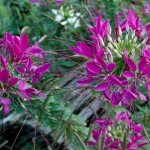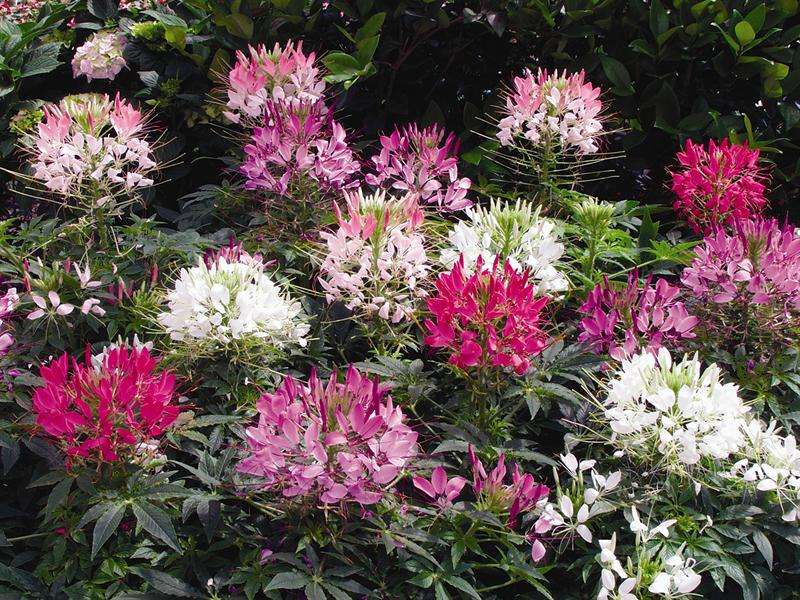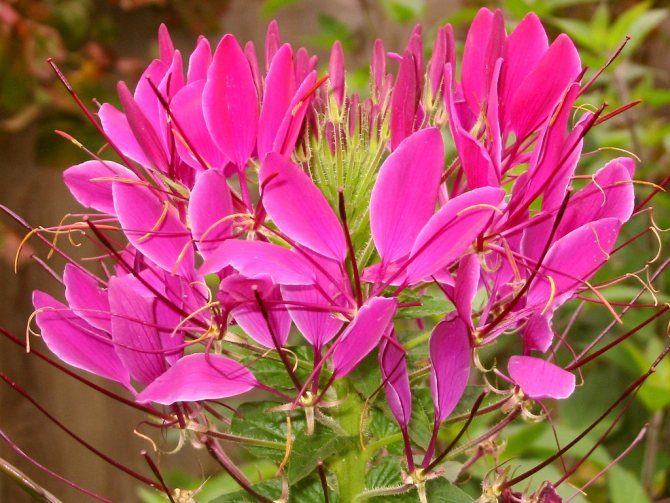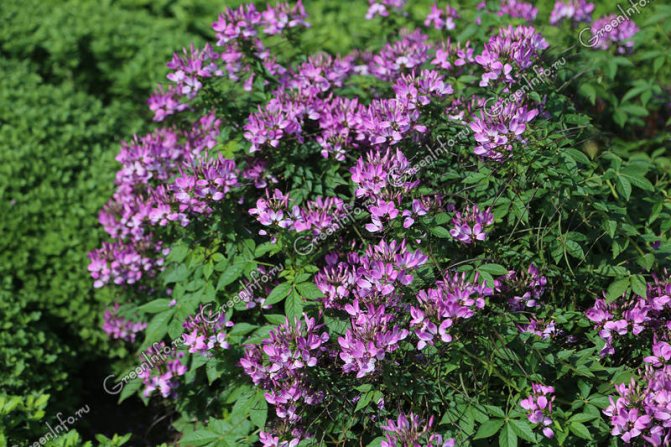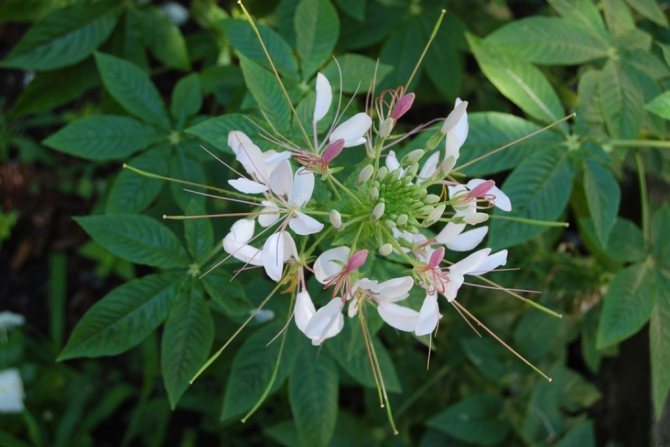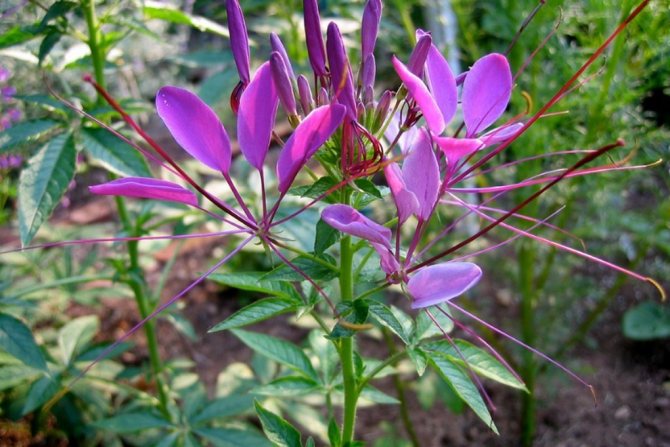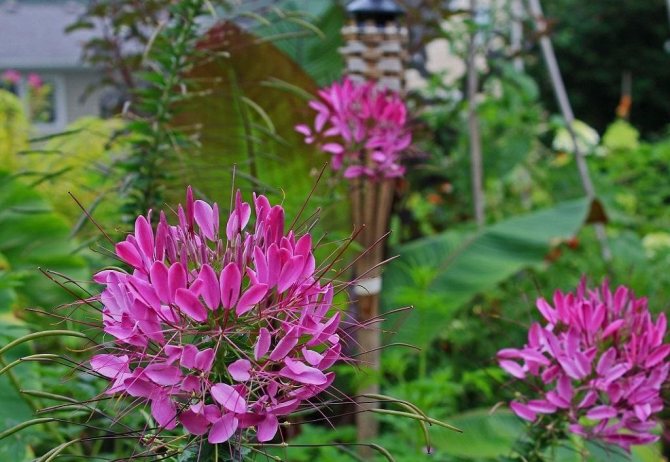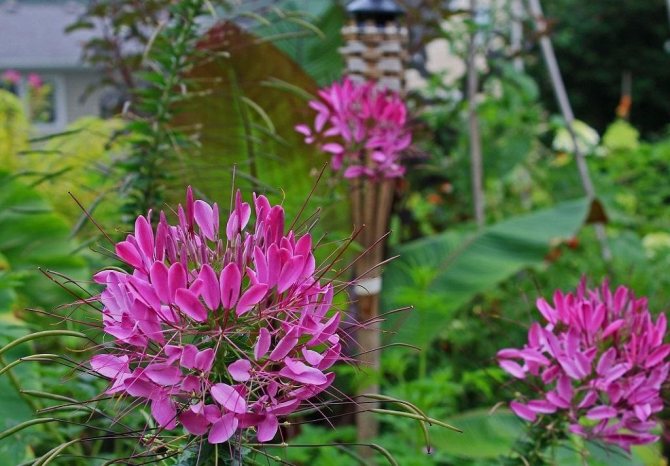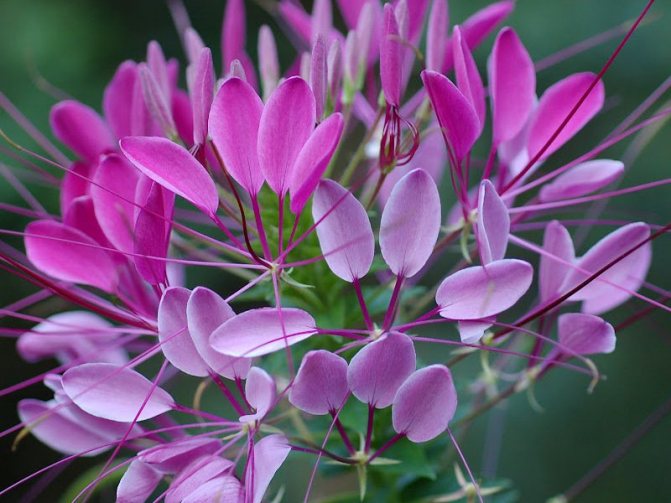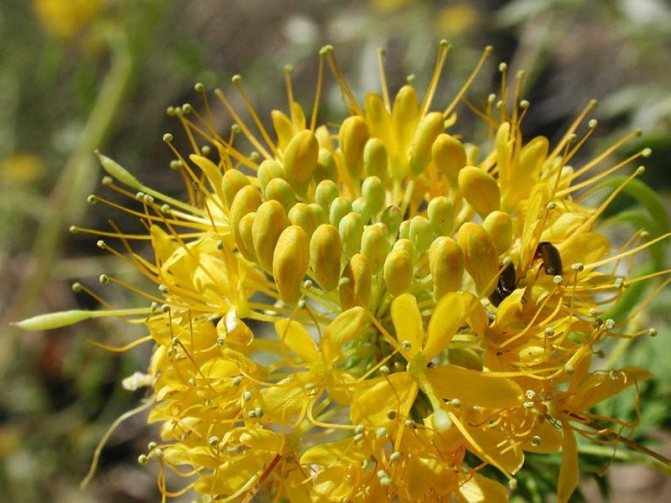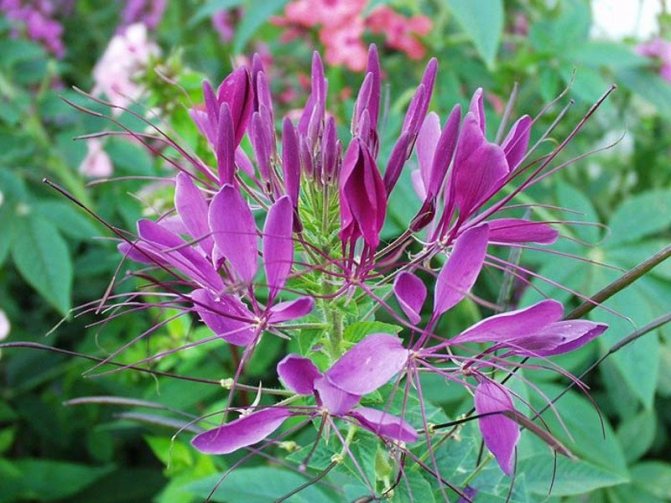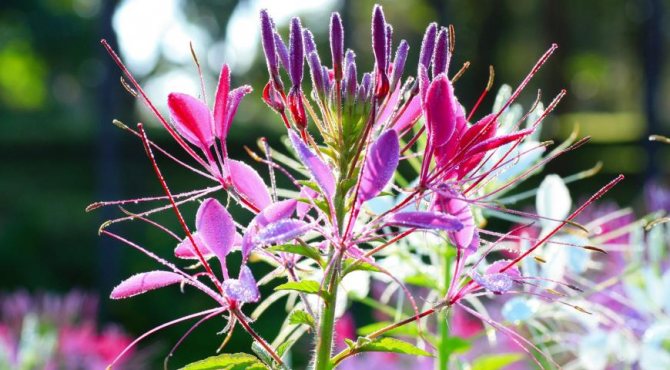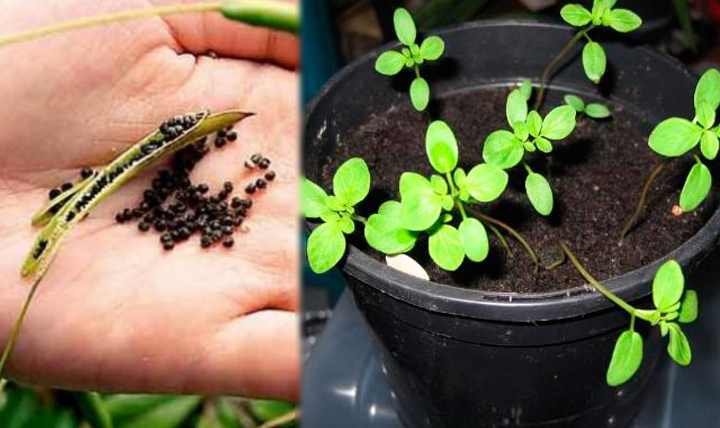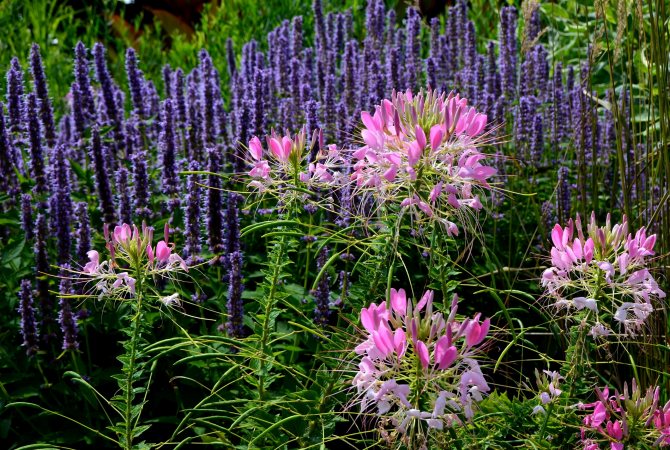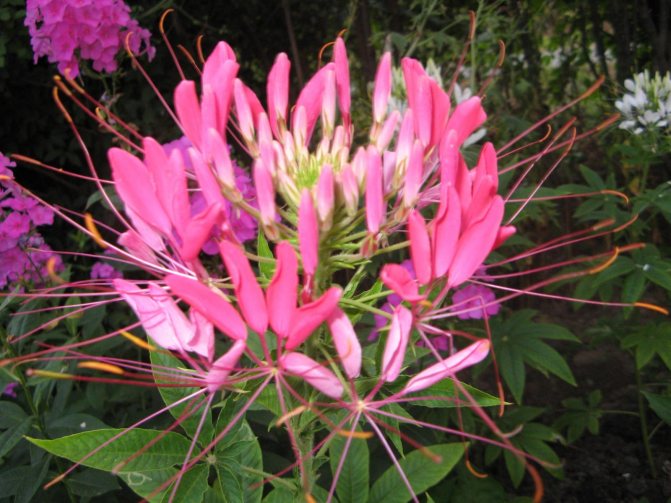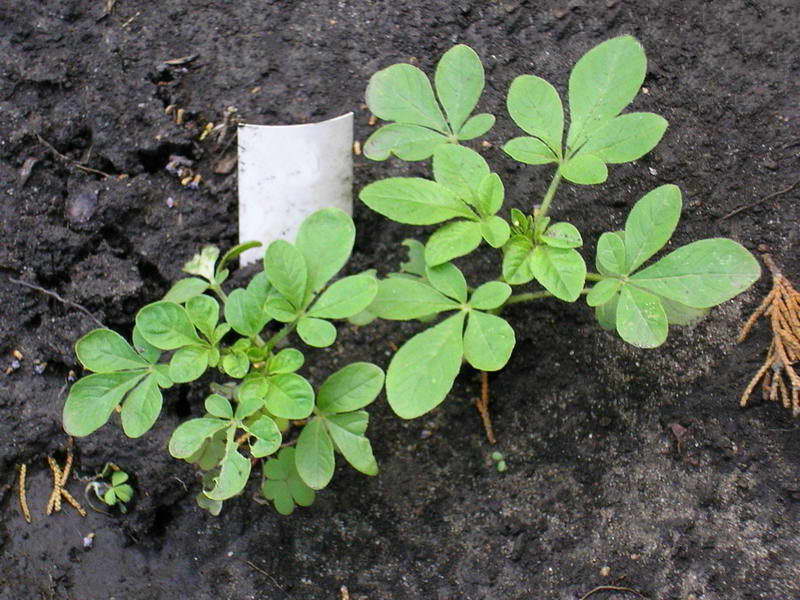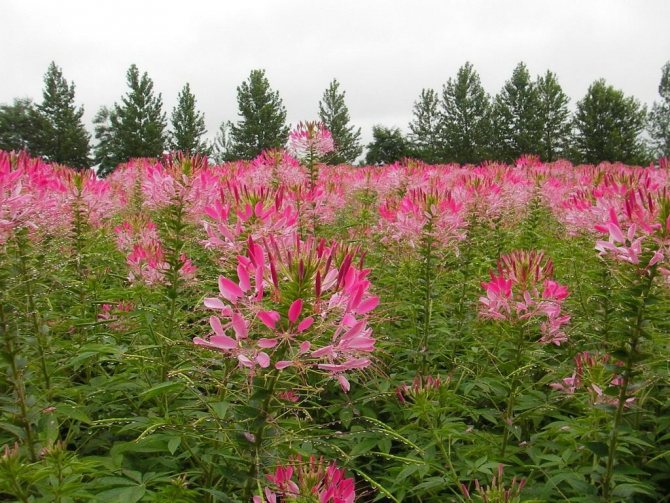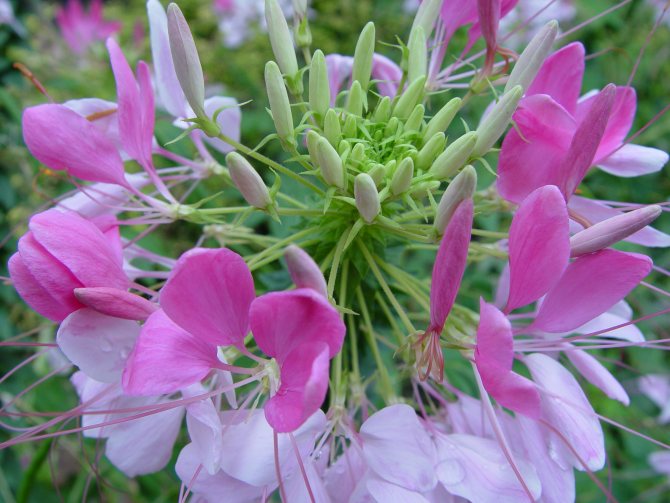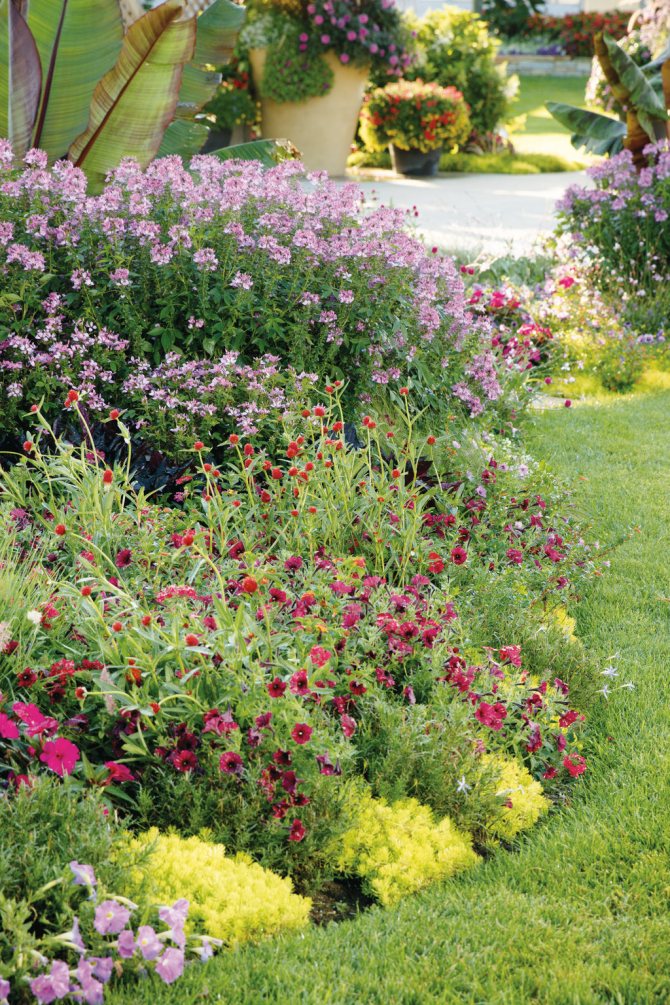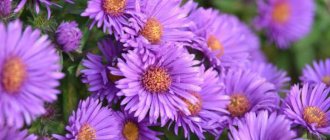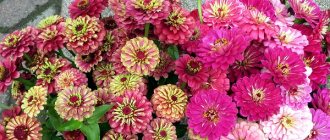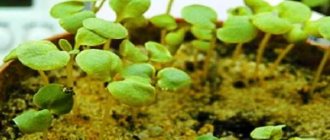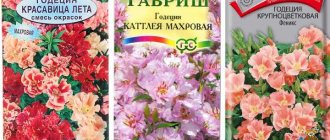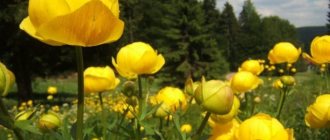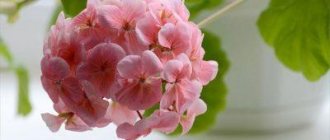How to cultivate a cleoma plant, growing from seeds, when to plant - these questions are relevant for gardeners who like this unusual flower. A semi-shrub up to 1 m high attracts with spectacular inflorescences of elongated petals of white, purple, yellow, pink color with long stamens-hairs in the form of champagne splashes.
Common species and varieties
Prickly
The leaves have stipules that look like thorns, which is why it is called prickly. Prefers light, acid-neutral soils. Seedlings are not friendly, appear in 10 days. This culture loves sunny places, does not tolerate waterlogging.... It blooms pink from June to September. Plant height 80-100 cm. Inflorescences have a specific smell.
- Cherry queen - the most common variety of prickly cleoma, height 50 cm, fragrant flowers.
- White Queen — a variety that has white inflorescences and blooms from June to September. Height 90-100 cm.
- Queen of roses - variety with dense pink inflorescences, blooms from June to September. Height 90-100 cm.
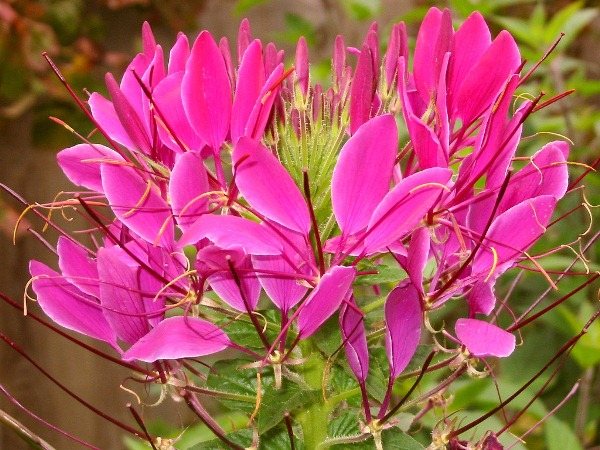
Cherry queen
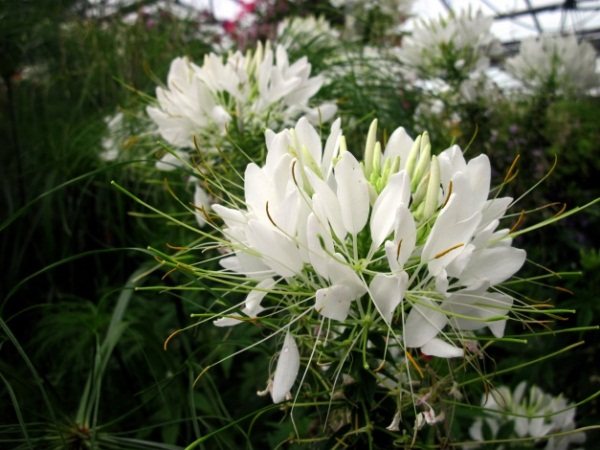

White Queen


Queen of roses
Hassler
It differs from prickly only in the color of the inflorescences, therefore, for convenience, gardeners combine these two species into one.
- Splashes of champagne - variety 1.2 m high with white-pink inflorescences. Blooms in July until frost.
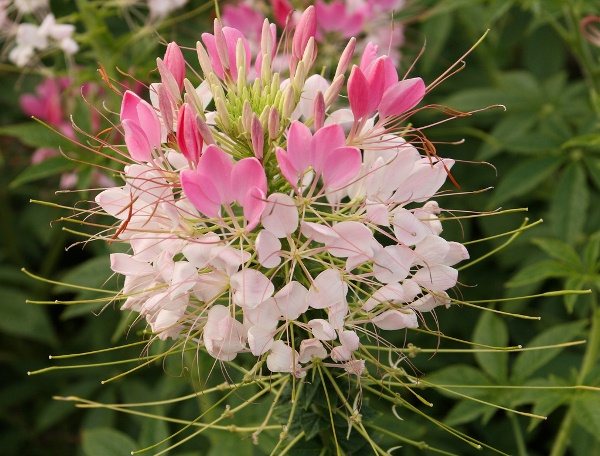

Cleoma Champagne Splash
Content:
- 1. Cleome hassleriana or "Splash of champagne"
- 2 Cleome spinosa
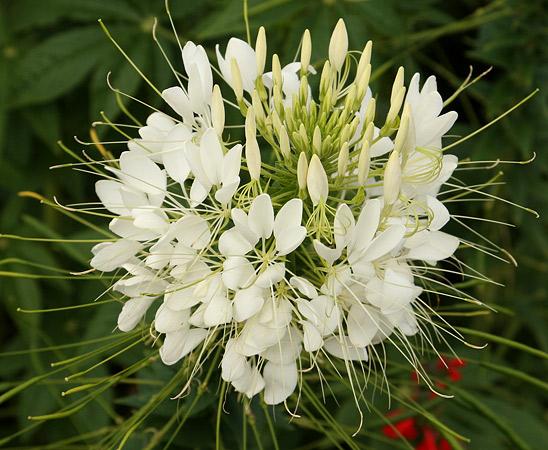

Cleome (Cleome) or, as it is called in another way, the spider flower, spider is a fairly large genus of flowering herbaceous plants. In floriculture, Hassler's cleoma and its hybrids with prickly cleoma are most used, which made it possible to obtain a variety of shades.
Landing in open ground
Seedling
Before sowing, the seeds are soaked in a solution of zircon or epin (2 drops per glass). The soil is prepared in the following proportions: take 2 parts of the garden mixture, 2 parts of humus and 1 part of sand. The soil is covered with glass or foil until sprouts appear.
The culture emerges in a month, it is desirable for it to provide additional illumination with the help of an ultraviolet lamp. Seedlings are planted in late May-early June, when frosts pass... Before planting, add 1 bucket of compost and 2 liters of universal fertilizer per m2. There should be a distance of 50-60 cm between the bushes, otherwise it is better not to wait for abundant flowering.
You can plant glue in peat pots, so you will not damage the root system during transplantation, which will increase the survival rate of the culture. If a plant at the age of seedlings was oppressed, then it will always be so.
Seeds
The seeds are harvested in the fall. The maturity of the seeds is determined by eye, they should be brown... Make gauze bags on the plant so that the burst pod spills the seeds into them.
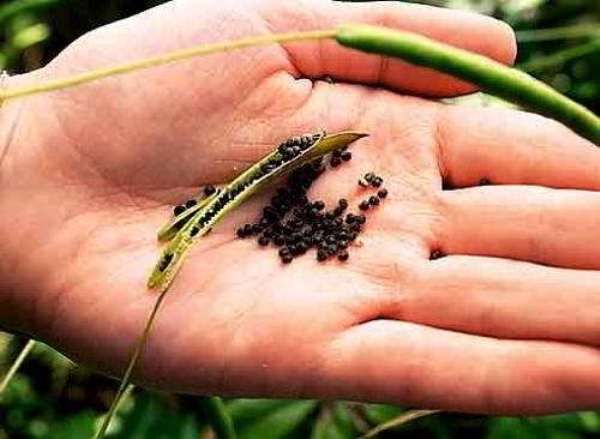

Ripe Cleoma Seeds
It is better to sow seeds in open ground at the end of April. Gardeners also practice sowing before winter at the end of November, after which they cover the ground with spruce branches.
For the prevention of root diseases in seedlings, a weak solution of potassium permanganate is used. Saplings root better if their roots are sprayed with Epin-extra stimulant and cytovite.
Growing cleoma from seeds: instructions for a beginner
Cleoma is a thermophilic flower in any form, so it feels more comfortable in southern latitudes.If you provide it with appropriate conditions, then it is possible to grow plantings in a cooler climate. It is for this reason that this plant is grown mainly in seedlings from seeds.
Novice gardeners are advised to first try to grow seedlings, and then try to sow seed directly into open ground. Sowing is also possible before winter - in October-November.
When to plant
When choosing the time for planting seeds, it should be borne in mind that they ripen for a long time... Certain negative external factors serve as an obstacle. So, with early spring sowing, a sharp drop in temperature at night can adversely affect the site. Weed grass constantly overcomes cleoma crops, which also does not have the best effect on seedlings.
If you are late with the dates, then even in the next season there will be no flowering.
When cleoma is planted in spring, flowering usually occurs in mid-July. With seedling germination, you can enjoy the first flowers already at the beginning of summer. But this is on condition that the process should start at the end of February or early March. Ready-made planting material is purchased at a florist shop. More often on sale is a mixture called "Colored Fountain". When choosing, it is recommended to pay attention to the seed collection period. Ideal if they are fresh. Then germination is better.


Sowing
Before starting sowing work at home, select the appropriate container and prepare the soil mixture. Small wooden boxes or standard flower pots will do. They are filled with self-made soil from the following components:
- garden land - 2 parts;
- humus - 2 parts;
- river sand - 1 part.
In order for the seeds to germinate faster, they are preliminarily subjected to stratification - they are soaked for 10-12 hours in any solution of a growth stimulator (Epin, Zircon). Add 3-4 drops of the product to warm boiled water (300 ml).
The prepared seeds are deepened into the soil by 1-1.5 cm. From above they are covered with the same substrate and sprinkled with wood ash. Cover crops with glass to create a greenhouse effect. Sprouts appear in 2 weeks.
Recent Entries
Rose Petal Jam and Its 7 Health Benefits You Likely Didn't Know About What Fruit Are You According to the Zodiac Sign 11 Best Grape Varieties That Will Help You Create Unique Homemade Wine
How to care for seedlings
Containers with seedlings are placed in a well-heated and sunny place. Before the first shoots appear, care consists in regular watering and airing (open the lid). Moisturize plantings once a day, but in moderation. It is impossible for the surface soil layer to dry out. For the sake of prevention, the seedlings are watered once with a weakly concentrated manganese solution.
It is advisable to create artificial lighting in the evening, since the seedlings will lack light in February-March.
As soon as 2-3 strong leaves appear, they begin to pick. Peat-humus cups or other small containers are ideal for this purpose. Cleoma reacts painfully to the transplant, so take it out of the box with care. It is advisable to capture the roots along with an earthen clod. Deepen them to cotyledon leaves.


Further manipulations:
- They feed for the first time in 10-12 days. Complex mineral supplements are used, which are applied once every half a month. The dosage is recommended to be taken two times less than that indicated in the instructions.
- The backlight is removed.
- Water abundantly, but infrequently. Prevents stagnation of water.
To prevent the plant from developing on one side, it is necessary to systematically turn it in different directions towards the light.
Care
Cleoma loves good lighting and cannot stand drafts. The plant does not tolerate stagnant moisture and loves moderately moist soil... For landing, you should choose a sunny, sheltered from the winds.


Before transplanting Cleoma seedlings to a flower bed, it is recommended to spray the rhizome with a growth stimulator and fertilizer Cytovit
Complex fertilizing with mineral fertilizers is carried out every 2 weeks. Before flowering, fertilize with mineral fertilizers in the proportion of 1 tbsp. spoon for 10 liters of water. Flowering will be accelerated by a solution of zircon (1 ml per 1 liter of water).
Cleoma is a fairly sprawling crop, so you need to make restrictions for it, for example, using stakes and twine.
Diseases.
The Cleoma plant has its own defense mechanism against pests and diseases - this is a specific aroma that its flowers exude. Thanks to this smell, the flower is avoided not only by insect parasites, but also by animals. Various types of rot can affect flowers, subject to excessive watering or stagnant moisture.
Overall, Cleoma is very good for decorating a site. Unpretentiousness and disease resistance make this flower easy to grow, and its decorative qualities are truly impressive.
The use of a flower in landscape design
This crop will look great in the background of mixborders and in group plantings. She will attract bees to your site. In the tropics, Cleoma attracts bats with its scent... The plant stands in water for a long time and is therefore used for cutting. One stem, placed in a vase, will look like a whole bouquet.


Cleoma is a delicate flower that deserves a place in any flower garden
Cleoma is combined with fragrant tobacco, Iberis, Lavater, as well as tall phlox, Echinacea, Rudbeckia. This culture looks good in curtains and high borders. Gardeners make a one-year hedge out of cleoma.
2. Cleome spinosa ↑
Height: up to 1.5 m. Color: pink, white. Stem: branched at the top, prickly. Flowers: 3-4 cm in size, form inflorescences up to 15 cm in diameter. Flowering period: late June until frost.
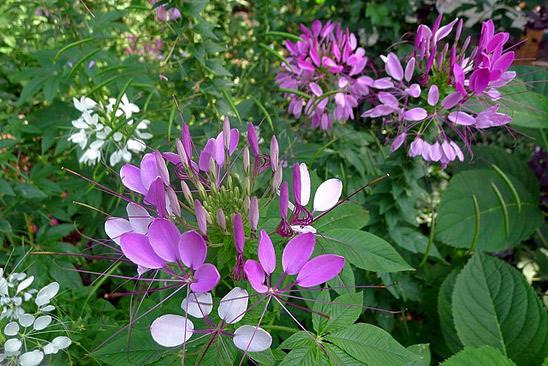

After the flowers have faded, numerous small pods form and begin to ripen. When the pods are ripe, they begin to burst and the seeds begin to fly out with great force, just like mad cucumbers. But unlike them, the seeds are dry, but it is still better to stay away.
How do you collect seeds? To do this, visually observe the glue at the end of summer and tear off all the boxes after the first ones burst. Or, tie the seedpods in fabric bags right on top of the plant in time. When the capsule bursts, the seeds are already ready-made in the bag. You just have to collect them!
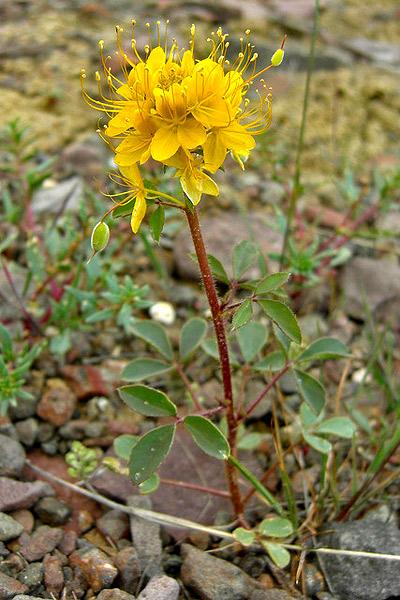

The main difference between varieties and hybrids is in color and height. They can be roughly divided into medium-high and high.
High grades (100-150cm)
White Queen - white, Cherry Queen - ripe cherry color, Pink Queen - pink, Violet Queen - lilac, Bright Pink - pale pink,
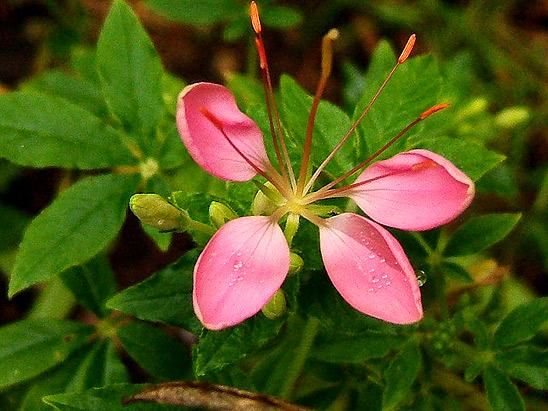

"Gigant Pink Queen" - dark pink, large flowers, "Rosekonigin" - light pink, "Color Fauntain" - a mixture of pink, mauve, lilac and white.


Reasons for non-germination of seeds
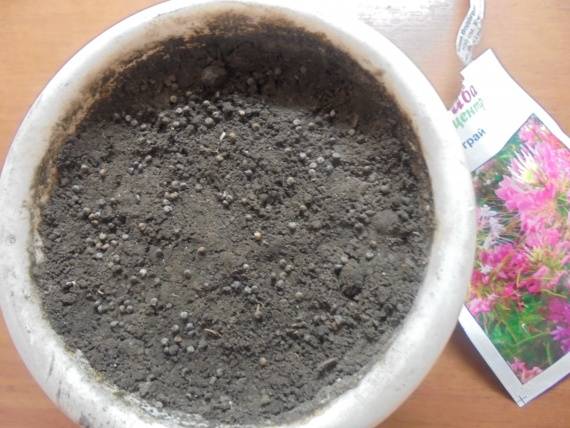

The small percentage of germination of cleoma seeds is explained only by the poor quality of the grains or a violation of the technology of growing a flower. When independently harvesting seed, grains must be taken from developed bushes with large inflorescences. Cleoma seeds are given time to mature inside the pods. Unripe grain will not germinate in spring.
To increase the percentage of germination, flower seeds are soaked in Epin before sowing. Excellent results are shown by a sharp change in temperature. The boxes with crops are exposed to the sun during the day, and at night they are taken out onto the balcony or into an unheated room.
Description of the plant
More recently, glue was rarely found in our gardens. But now she is gaining more and more popularity among experienced florists.Interestingly, cleoma leaves resemble hemp in shape and appearance. But cleoma has nothing to do with this plant.
Cleoma is covered with long hairs from crown to heels. The hairs are like the prickly needles of a cactus. Therefore, the people call glue prickly. Many are repelled by the smell that this plant exudes. In length, the plant can reach 1.5 meters. The roots of the flower are very long, thick and powerful. They are capable of retaining moisture, so the cleome does not need frequent watering.
The plant blooms from early summer to mid-autumn. After flowering, seed pods are formed. The seeds can then be used for plant propagation.
Good to know! The birthplace of the flower is considered to be South America.
Cleoma flowers of different shades and shapes. Flowers bloom in huge numbers and bloom very luxuriantly.
Variety of varieties
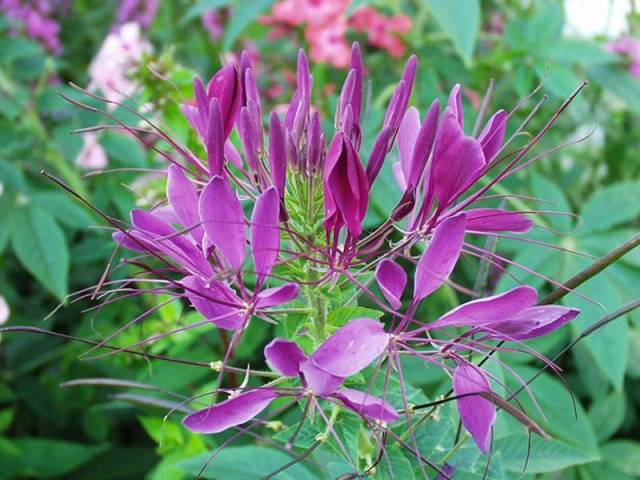

Considering the photo of a cleoma flower and the rules of cultivation, it is worth briefly dwelling on the varieties. Domestic gardeners grow only two species: Hassleriana and Spinosa. It is difficult for a layman to find differences in varieties. Gardeners have combined the flower into one species - prickly cleoma.
Now many new varieties have been bred. All flowers are obtained by crossing two types of glue. The result is bushes with beautiful inflorescences of white, pink, purple. The most popular variety is Cherry Queen. The stems of the bushes grow up to 60 cm in height. The flowers give off a pronounced aroma and grow up to 3 cm in diameter.
Growing cleoma: choosing the time and preparing the soil
In the southern latitudes of our country, cleoma seeds can be planted immediately to a permanent place, and in temperate latitudes it is propagated exclusively by seedlings. A long period before flowering suggests early sowing, therefore, seeds are sown for seedlings in the 2nd decade of March. You should prepare a soil mixture by mixing garden soil with humus in equal parts and add river sand - a quarter of the specified amount. By the way, if it is not possible to prepare the necessary soil, you can buy it in the store.
Neighborhood with other plants
The spectacular appearance of cleoma is often used to decorate flower beds along a house, fence or any other fence. The tall stem and thorns of the plant create a unique hedge. Low-growing varieties can be used for framing paths or group planting. Cleoma is best combined with garden asters, Salvia, some varieties of marigolds and echinacea. Savlia seeds must be sown before winter or early spring.
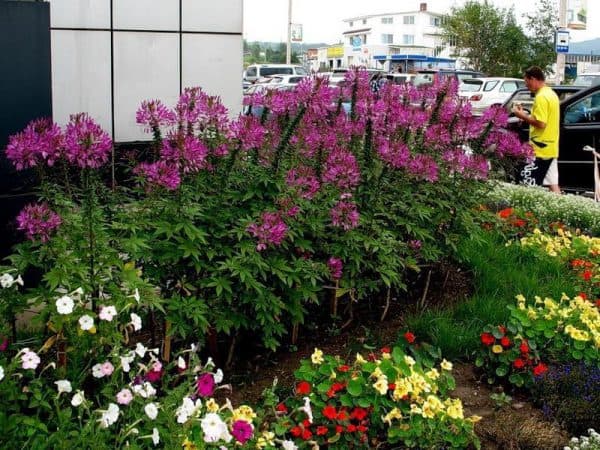

Neighborhood with other colors
The plant looks advantageous to decorate a country-style plot. Single shrubs can complement conifers and green vegetable beds. If the plant is used for framing buildings, then it can be combined with climbing or climbing cobbies. Note that for growing kobei climbing from seeds, you need to make special arches or supports.
The release of the insect repellent scent can be used for practical purposes. Blooming cleoma helps keep other plants safe from contamination as the scent spreads within a radius of several meters.
Most popular types
When deciding which plants to plant to decorate a summer cottage, you can safely consider glue, since there are more than 200 types and varieties of it, two types are among the most beautiful and popular. Cleoma Hassler, who came from South America and took root well in the middle lane, but only as an annual. It does not grow taller than a meter, but can be successfully used as a hedge.
Cleoma prickly amazes with a variety of varieties that can be grown in summer cottages:


Hellen Campbell has beautiful white flowers, collected in large inflorescences.- Violet Queen is a variety that will delight the eye with its deep purple bloom.
- The cherry queen reaches a height of just over 50 cm and is distinguished by an unusual shape of fragrant buds. For the first time this plant appeared in 1817 and managed to gain popularity all over the world. It does not differ in long flowering, but it will impress with the true beauty of pink, pale lilac or white petals. It belongs to rather demanding plants, needs a well-lit area and high-quality soil.
- Splashes of champagne. In favorable conditions, it reaches a height of more than a meter, has flowers of delicate shades (pinkish or light purple).
- Giant Pink Kewsen - the owner of large buds of pink-purple color, has a long flowering period.
Regardless of the variety chosen, you should know the rules for caring for the plant, only in this case you can expect that a thermophilic guest from the tropics will feel comfortable, take root and flourish with its inherent splendor.
Selection of partners for cleoma
Cleoma prickly will attract attention in any company. The best partners, shading the beauty of the plant, are rightly considered low-growing, flowering annuals or spicy herbs, for example, oregano, sage and hyssop.
Excellent partners for cleoma will be annual verbena, kosmeya, scented tobacco, annual phlox, brilliant sage, lavater, zinnias, delphiniums, nasturtiums, heliotropes, calendula. Of perennials, cleoma looks good together with rudbeckia, yucca, echinacea, roses, ornamental grains, any plants with basket inflorescences, as well as with all ornamental deciduous crops without exception.
Unexpectedly, prickly cleoma combines well with large climbing vegetables - cucumbers, beans, zucchini, growing nearby allows you to achieve better pollination of both crops.
Plant care
Flowers require simple maintenance: abundant watering only on hot days, root dressing once every 15 days with a complex product such as Fertika - luxury. Two tablespoons per ten-liter bucket.
Sick and weak bushes are fed on foliage, spraying with a solution of 1 teaspoon of fertilizer in a three-liter container. Before starting the formation of buds, you can spray a glue solution of zircon by taking for 1 liter of liquid 1 ml of the product... Flowering will be early and abundant. In addition, care involves loosening the soil, as well as removing weeds.
When and how to collect seeds?
Since cleoma is grown only from seeds, it is required in the fall, after they ripen, they must be prepared for sowing in the spring. Ripe seeds are round in shape, one and a half centimeters in diameter, brown or yellow (depending on the color of the flowers).
If you miss the moment of collection, you can place several pods in small gauze bags. Then the seeds cannot fall to the ground.
Cleoma in winter
Cleoma is an annual, therefore, before the onset of the first frost, it must be disposed of. You can sow the collected seeds again in November or December in the ground to a depth of 1 - 2 cm... Cover the sowing with spruce branches. In the spring, remove it so that the seeds that have wintered in the soil begin to grow.
Why did cleoma not sprout
A common problem when you want to have glue on the site is that the seeds are not very similar. The reason is simple - by themselves, cleoma seeds are difficult to maintain their germination, which is why they are difficult to germinate, but this can be achieved. Perhaps the reason why cleoma seeds do not want to germinate is old or low-quality seed. If the usual method of germination has not yielded results, then a simple manipulation of the seeds can be done when they are already placed in the soil.
Lithops are a miracle of nature, living stones, amazing and not unique in nature.
Mesembriantemum flower, perfect for decorating balconies and flower beds, read more about these flowers here.
The trays in which the prickly cleoma seeds are located must be rearranged in places with different temperature conditions. During the day, you should leave it in the sun or in a room with a high temperature, and at night you can even send it to the refrigerator. A good option would be to place the glue on a loggia or balcony, where there is a big difference in day and night temperatures, then you do not have to rearrange the seeds every day from place to place.
Attention: Seeds for germination must be fresh, as they quickly lose a large percentage of germination.
Cleoma in the garden
The gardener does not require special requirements for the site of planting and leaving the cleoma. The flower belongs to those plants that have been planted and forgotten. Cleoma will remind herself of herself with chic and unusual flowers. The only thing to remember is that cleoma is afraid of cold weather. The time for planting in the garden comes after the threat of frost has passed.
Cleoma flower on video, view overview:
The plant is very sun-loving and thermophilic; it is better to place it in well-lit places. Cleoma will grow in the shade, but varietal qualities will not be fully manifested. The plant needs a soil with a neutral reaction, it can be placed on slightly acidic or slightly alkaline soils with good drainage. The plant does not tolerate waterlogging and stagnant water. In watering, the cleoma shrinks in a particularly dry summer.
The most popular varieties of cleoma:
- Queen cherry
- Queen purple
- Rozakenengin, pink flowers
- Giant Pink Küssen, pink flowers, large
- Golden sparkler, dwarf, yellow
- Helen Kemball, white flowers
- Color Fontaineen, multicolored
If the variety is chosen, then it remains only to plant it correctly.
Description
Cleoma belongs to the cleome family, which includes more than 70 species of various shrubs or herbaceous plants. Almost all members of the family have a strong rhizome with a large number of woody branches. The erect stem can reach a height of 150 centimeters and quickly stiffens in comfortable conditions. Several flexible shoots are located at its top, and practically all green parts of the plant have sticky villi necessary to retain and retain moisture.
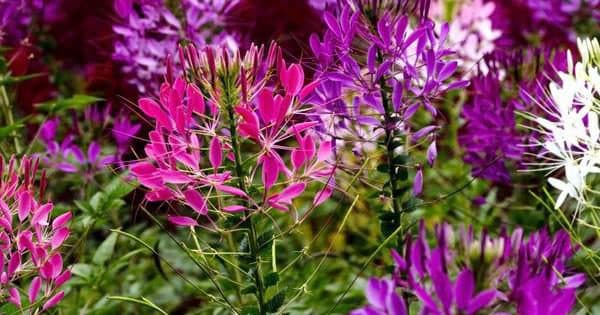

Cleoma flowers
Complicated in structure, pinnate leaves resembling chestnut are symmetrically located on the stems. Small thorny stipules can be seen at the base of the leaves.
The flowers have a pleasant muted color of pink, white or purple. Each spherical inflorescence grouped on a receptacle is quite large - about 20 centimeters. The flower consists of 4-6 petals with long filamentous stamens in the center. The flowering of the plant begins from the bottom and lasts almost the entire summer period. Cleomas have a distinctive, pungent floral scent that attracts not only insects but also some small animals such as bats or birds. The fruits are long pods that almost never fully ripen in cold climates.
Among the people, cleoma has many names: spider, flower bouquet or spider flower. The plant received such nicknames for the unusual appearance of flowers, the general outlines of which really resemble some kind of strange insect.
Sowing seeds
Cleoma propagates by seeds, both seedling and non-seedling.
For seedlings, seeds are sown in March, about 8 weeks before planting in open ground. To increase germination, it is good to treat them with a solution of Epin, Zircon or Lignohumate. The seeds are germinated at a temperature of + 26 ... + 30 ° C during the day and + 20 ° C at night. Seedlings appear spontaneously for a week or more, and when treated with stimulants - after 4-6 days.
Soil for sowing requires preliminary preparation - adding ash to it, because the plant gravitates towards neutral soils. You can simply cover rows with crops with ash. The seeds should be no deeper than 3 cm.After the appearance of the first true leaves, additional lighting is organized, otherwise the crops will be greatly extended. The temperature of the content is reduced to + 22 ° C. Seedlings are planted in open ground at the end of spring frosts.
Cleoma grown through seedlings grows rapidly and blooms as early as June. But you can sow it directly into open ground, after the last frost. But in this case, flowering will be short-term, because the plant requires a long growing season.
Cleoma is capable of self-seeding, but the parental traits of the plant may not be preserved if the variety is of hybrid origin.
Cleoma flower: growing for the soul
Many growers appreciate the beauty and simplicity of this culture. Long flowering, unusual appearance, pleasant and light aroma - thanks to all this and easy care, the flower finds new admirers among the leading Russian gardeners.
Perfectly compatible with other plants, the cleoma flower, which is easy to care for, will create a magnificent bright holiday in the afternoon, and in the evening - a quiet, cozy little paradise at the summer cottage.
The spider plant is the name given to glue in Germany. Some compare its flowers to a spray of champagne, some to a flock of dragonflies. In any case, the plant is very spectacular, expressive, with unusual, flying flowers, with long stamens.
The aroma of the plant is quite peculiar, even unpleasant, the fact is that in the homeland of cleoma, this smell is designed to attract bats that pollinate the plant.
Diseases
Since the glue does not emit a very pleasant smell, insects practically do not attack. But if this happens, be sure to use only special preparations for the destruction of pests.
The plant is rarely sick. Most often, problems are associated with a violation of care. Rot may occur on the roots of the flower. If the lesion is too severe, it is best to dispose of the plant. Initially, use healing solutions that are sold in any flower shop.
Cleomas - the flowers are bright and unusual. Despite their unpleasant smell, landscape designers are happy to use these plants to decorate facades, gardens, and localities. Cleomes are grown as a living fence, for decoration in flower beds and in greenhouses. Plants do not require much effort, so everyone can handle them. Cleomas can be planted next to other flowers, so you can create unusual compositions in your garden.
Top dressing
Cleoma is a southerner, and this could not but affect her preferences. She loves calm, well-warmed sunny places. She is indifferent to soil fertility, but responds well to care and fertilization. It calmly tolerates heat and periodic drought, but waterlogging can cause irreparable harm to it. It should be remembered that cleoma is a plant with a strong root system. It grows well over the season, so it must be planted at intervals of 0.8-1 m. As weeds appear, it is necessary to periodically weed and loosen the soil layer.
Fertilizing the culture is certainly needed. In total, they should be performed 2 or 3 times. You need to look closely at the growth of seedlings. If it develops poorly, it is necessary to use a solution of biostimulants, which can be sprayed 1-2 times. 7-10 days after planting in a permanent place, the flowers are fed with any organic matter: humus, liquid manure solution. If there is no organic fertilizer, a complex mineral fertilizing will do. For example, "Kemira". For better and more abundant flowering in June, the flower is fed again. As a rule, the plant does not need any more fertilizers.
What is the best time to land
By the time of disembarkation, the seedlings should be 45-60 days old.It is worth adding to this age the seed germination period - about 15–20 days.
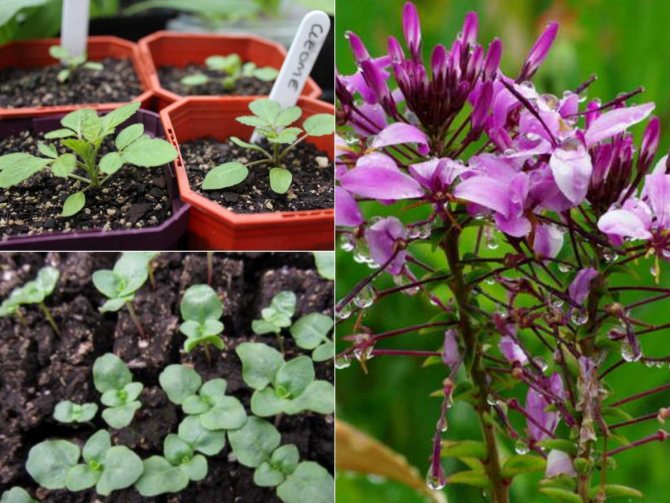

The term for sowing cleoma depends on the region of the location of the suburban area
In accordance with climatic conditions, glue is sown on seedlings in the following terms:
- Southern regions - early February.
- The middle strip is the end of February or the beginning of March.
- Siberia, the Urals and the Leningrad Region - the last days of March.
The best sowing dates according to the lunar calendar 2019
In accordance with the lunar calendar for 2019, the most favorable days for sowing cleoma:
- February - 17th;
- March - from 10 to 16, 19–20 and 23–24;
- April - 7-8, 11-12, 16-17, 20-21.
Unfavorable days for sowing:
- February 21-28,
- from 1–5 and from 22 to 31 March,
- from 1 to 3 and from 20 to 30 April.
Dangerous diseases and pests
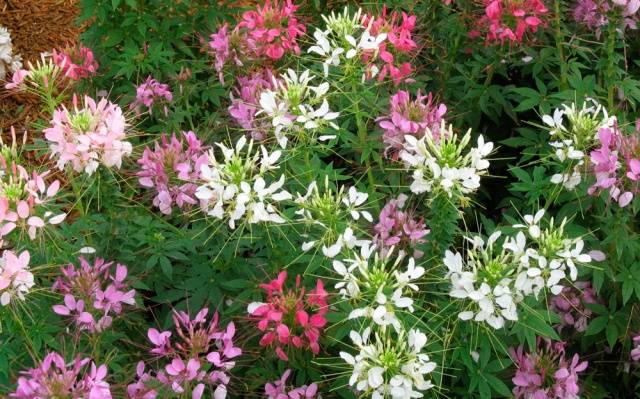

Cleoma has adapted to the environment so much that its scent does not deter only beneficial pollinating insects. All pests try to fly around this flower. Sometimes vegetable growers plant a couple of cleoma bushes around the garden beds. The emitted smell scares away pests, and the bees boldly do their useful job.
A flower can only get sick through the fault of a gardener or a rainy summer. Frequent watering, rains and closely spaced groundwater will lead to rotting of the root system of the bush.

